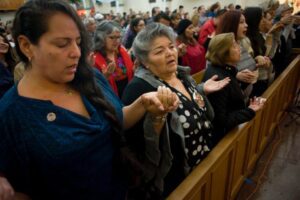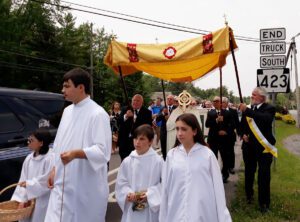VATICAN CITY (CNS) – Catholics need to recover a sense of awe and adoration before the Eucharist, knowing that it is “the real and loving presence of the Lord,” Pope Francis told members of the committees organizing the National Eucharistic Revival and the National Eucharistic Congress in the United States.
Jesus spoke of himself as “the living bread which came down from heaven, the true bread that gives life to the world,” the pope told the group June 19, just three days after leaving the hospital following abdominal surgery.

“This morning, while I was celebrating the Eucharist, I thought about this a lot because it is what gives us life,” the pope said. “Indeed, the Eucharist is God’s response to the deepest hunger of the human heart, the hunger for authentic life because in the Eucharist Christ himself is truly in our midst to nourish, console and sustain us on our journey.”
Pope Francis walked into the library using his cane instead of a wheelchair. And although he sat when he read his prepared text — and added spontaneous comments — he stood to bless the four-foot-tall monstrance, paten and chalice that will be used during the eucharistic congress in Indianapolis July 17-21, 2024.
The group was led by Bishop Andrew H. Cozzens of Crookston, Minnesota, chair of the U.S. bishops’ advisory group for the National Eucharistic Revival, a multi-year process aimed at renewing and strengthening faith in the real presence of Christ in the Eucharist, and chair of the board of directors planning the eucharistic congress.
Bishop Cozzens told Catholic News Service it was “an incredible privilege” to meet the pope and experience “his love, his passion for the Eucharist and for the work that we’re about.”
Pope Francis told the group that, unfortunately, today many Catholics “believe that the Eucharist is more a symbol than the reality of the Lord’s presence and love.”
But, he said, “it is more than a symbol; it is the real and loving presence of the Lord.”
“It is my hope, then, that the eucharistic congress will inspire Catholics throughout the country to discover anew the sense of wonder and awe at the Lord’s great gift of himself,” he said, “and to spend time with him in the celebration of the holy Mass and in personal prayer and adoration before the Blessed Sacrament.”

Pope Francis lamented that many people “have lost the sense of adoration. We need to regain the sense of adoring in silence, adoration. It is a prayer we have lost; few people know what this is, and you bishops need to catechize the faithful on the prayer of adoration,” he said, looking at Bishop Cozzens and Bishop Kevin C. Rhoades of Fort Wayne-South Bend, Indiana, who also accompanied the group.
The pope insisted on the link between celebrating Mass, eucharistic adoration and sharing the Gospel with others.
“In the Eucharist, we encounter the one who gave everything for us, who sacrificed himself in order to give us life, who loved us to the end,” he said. “We become credible witnesses to the joy and transforming beautify of the Gospel only when we recognize that the love we celebrate in this sacrament cannot be kept to ourselves but demands to be shared with all.”
“This is the sense of mission: You go, you celebrate Mass, you take Communion, you go to adoration — and afterward?” he asked. “Afterward you go out, you go out and evangelize; Jesus makes us this way.”
“The Eucharist impels us to a strong and committed love of neighbor,” he insisted. “For we cannot truly understand or live the meaning of the Eucharist if our hearts are closed to our brothers and sisters, especially those who are poor, suffering, weary or may have gone astray in life.”
Speaking off the cuff, the pope said those who believe in the Eucharist must reach out to and visit “the elderly, who are the wisdom of a people, and the sick, who take the form of the suffering Jesus.”
Pope Francis prayed that the National Eucharistic Congress would “bear fruit in guiding men and women throughout your nation to the Lord who, by his presence among us, rekindles hope and renews life.”
In an interview with CNS following the papal audience, Bishop Cozzens said the ongoing process of the Synod of Bishops on synodality and the eucharistic revival are related since, in the listening sessions for the synod, many Catholics expressed concern about a lack of belief in the real presence and about declining Mass attendance.
“We’re probably at an all-time low in the United States in terms of the percentage of Catholics who are actually going to Mass every Sunday,” he said, which is “a huge concern that came forward in the synod process.”
The listening sessions also pleaded with the bishops to work for the unity of the church in the country and draw everyone together around the sacrament of unity, and communion is the best way to do that, he said. “So, I would argue that the synodal process helped us build the whole thing.”
“The Eucharist is the source of our life in the church,” the bishop said. “It’s the beating heart of the church where we receive the life of Christ as the body of Christ.”












